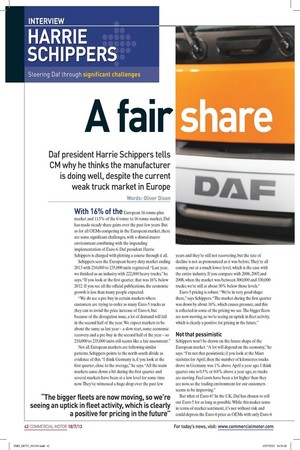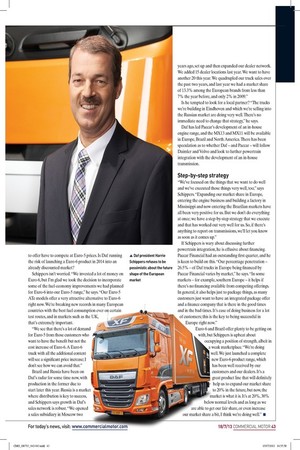A fair Daf president Harrie Schippers tells CM why he
Page 34

Page 35

If you've noticed an error in this article please click here to report it so we can fix it.
thinks the manufacturer is doing well, despite the current weak truck market in Europe With 16% of the European 16-tonne-plus market and 11.5% of the 6-tonne to 16-tonne market, Daf has made steady share gains over the past few years. But as for all OEMs competing in the European market, there are some significant challenges, with a dismal macro environment combining with the impending implementation of Euro-6. Daf president Harrie Schippers is charged with plotting a course through it all.
Schippers sees the European heavy duty market ending 2013 with 210,000 to 235,000 units registered. "Last year, we finished as an industry with 222,000 heavy trucks," he says. "If you look at the first quarter, that was 16% below 2012. If you see all the official publications, the economic growth is less than many people expected.
"We do see a pre-buy in certain markets where customers are trying to order as many Euro-5 trucks as they can to avoid the price increase of Euro-6, but because of the derogation issue, a lot of demand will fall in the second half of the year. We expect markets to be about the same as last year — a slow start, some economic recovery and a pre-buy in the second half of the year — so 210,000 to 235,000 units still seems like a fair assessment."
Not all European markets are following similar patterns. Schippers points to the north-south divide as evidence of this. "I think Germany is, if you look at the first quarter, close to the average," he says. "All the main markets came down a bit during the first quarter and several markets have been at a low level for some time now. They've witnessed a huge drop over the past few years and they're still not recovering, but the rate of decline is not as pronounced as it was before. They're all coming out at a much lower level, which is the case with the entire industry. If you compare with 2006,2007, and 2008, when the market was between 300,000 and 330,000 trucks, we're still at about 30% below those levels."
Euro-5 pricing is robust. "We're in very good shape there," says Schippers. "The market during the first quarter was down by about 16%, which causes pressure, and this is reflected in some of the pricing we see. The bigger fleets are now moving, so we're seeing an uptick in fleet activity, which is clearly a positive for pricing in the future."
Not that pessimistic Schippers won't be drawn on the future shape of the European market. "A lot will depend on the economy," he says. "I'm not that pessimistic; if you look at the Maut statistics for April, then the number of kilometres trucks drove in Germany was 1% above April a year ago I think quarter one is 0.5% or 0.8% above a year ago, so trucks are moving. Fuel costs have been a lot higher than they are now, so the trading environment for our customers seems to be improving."
But what of Euro-6? In the UK, Daf has chosen to roll out Euro-5 for as long as possible. While this makes sense in terms of market sentiment, it's not without risk and could depress the Euro-6 price as OEMs with only Euro-6 to offer have to compete at Euro-5 prices. Is Daf running the risk of launching a Euro-6 product in 2014 into an already discounted market?
Schippers isn't worried. "We invested a lot of money on Euro-6, but I'm glad we took the decision to incorporate some of the fuel-economy improvements we had planned for Euro-6 into our Euro-5 range," he says. "Our Euro-5 ATe models offer a very attractive alternative to Euro-6 right now. We're breaking new records in many European countries with the best fuel consumption ever on certain test routes, and in markets such as the UK, that's extremely important.
"We see that there's a lot of demand for Euro-5 from those customers who want to have the benefit but not the cost increase of Euro-6. A Euro-6 truck with all the additional content will see a significant price increase; I don't see how we can avoid that."
Brazil and Russia have been on Daf's radar for some time now, with production in the former due to start later this year. Russia is a market where distribution is key to success, and Schippers says growth in Daf's sales network is robust. "We opened a sales subsidiary in Moscow two years ago, set up and then expanded our dealer network. We added 15 dealer locations last year. We want to have another 20 this year. We quadrupled our truck sales over the past two years, and last year we had a market share of 13.3% among the European brands from less than 7% the year before, and only 2% in 2009."
Is he tempted to look for a local partner? "The trucks we're building in Eindhoven and which we're selling into the Russian market are doing very well. There's no immediate need to change that strategy," he says.
Daf has led Paccar's development of an in-house engine range, and the MX13 and MX11 will be available in Europe, Brazil and North America. There has been speculation as to whether Daf — and Paccar — will follow Daimler and Volvo and look to further powertrain integration with the development of an in-house transmission.
Step-by-step strategy "We've focused on the things that we want to do well and we've executed those things very well, too," says Schippers. "Expanding our market share in Europe, entering the engine business and building a factory in Mississippi and now entering the Brazilian markets have all been very positive for us. But we don't do everything at once; we have a step-by-step strategy that we execute and that has worked out very well for us. So, if there's anything to report on transmissions, we'll let you know as soon as it comes up."
If Schippers is wary about discussing further powertrain integration, he is effusive about financing. Paccar Financial had an outstanding first quarter, and he is keen to build on this. "Our percentage penetration — 26.5% — of Daf trucks in Europe being financed by Paccar Financial varies by market," he says. "In some markets — for example, southern Europe — it helps if there's no financing available from competing offerings. In general, it also helps just to package things, as many customers just want to have an integrated package offer and a finance company that is there in the good times and in the bad times. It's ease of doing business for a lot of customers; this is the key to being successful in Europe right now."








































